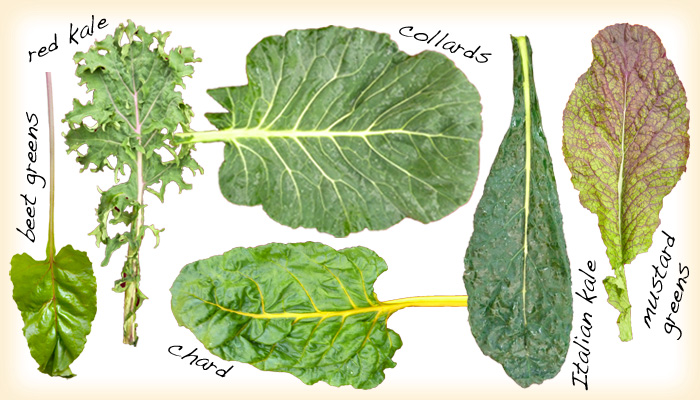Hearty Greens 8 Ways to Sunday
 Greens suffer a bad rap. Maligned by children and even some adults, greens often see their fate in the form of a putrid brown puddle in the refrigerator. Lying in wait atop one another at the market, these frilly, wavy bundles in varying hues are often passed over like a girl waiting to get asked to dance.
Greens suffer a bad rap. Maligned by children and even some adults, greens often see their fate in the form of a putrid brown puddle in the refrigerator. Lying in wait atop one another at the market, these frilly, wavy bundles in varying hues are often passed over like a girl waiting to get asked to dance.
But some confess to feeling “weird” if a day goes by without greens on their plate, like an artist’s palette lacking an essential daub of pigment. If you haven’t done so, it’s time to give these hearty greens (or cooking greens) a whirl. Though greens can encompass broccoli, bok choy, cauliflower and cabbages, the greens we’re talking about are of the hearty leafy variety—the spinaches, kales, chards, turnip, mustard, collard and beet greens. And that’s just a partial list.
Greens carry a rich array of vitamins and minerals like potassium, vitamin A, folic acid, magnesium and calcium. They’re also high in fiber and help reduce the risk of some cancers and cardiovascular disease. Though you’ll find greens year round, the hearty greens are superior in the colder weather. They work harder in the cold and this sped-up metabolism makes them sweeter and more crisp. They are a beacon in the grey days of winter, being one of the few colors around.
We eat salads with abandon. But most cooking greens, require, well, cooking, which many of us shy away from. But not only are these greens more nutritious than salad greens, they’re forgiving and versatile. Once you find a good way to cook greens, you can switch them up, swapping kale for chard, turnip greens for collards. Alter your seasonings—Asian one day, southern the next, Italian the day after. In other words, improvise!
How to Buy, Store and Use
Look for firm greens, unmarred by yellowish areas. Store the greens in plastic bags in the fridge and wash them well in cold water before using. Greens are enlivened by a splash of lemon or vinegar, as well as hot pepper. They pair beautifully with neutral flavors like potatoes and beans and can be added to soups or pasta. Greens such as spinach, chard and beet greens are tender and cook faster than the more sturdy kales and collards, so adjust cooking times as necessary. The sturdier greens have tougher stems; most often, you’ll want to remove the center rib. To do so, hold the end of the stem in one hand and grasp the leaf in the other, stripping the leaf off the rib. Chard stems can be used if cooked ahead, usually with onions, and before adding the leaves. Mustards, turnip greens and some kales are slightly bitter or spicy, adding punch to a dish.
Given that there are only a few market weeks left, it is possible to freeze greens. Just wash and chop them and store in freezer bags.
Recipes
We’ve compiled eight recipes (below) from chefs around town, lovers of greens who were eager to share a favorite way to enjoy them. Click on each recipe title to download a PDF.
Braising Greens Gratin
Scott Dolich is chef-owner of Park Kitchen, a restaurant celebrated for its devotion to local ingredients in a menu that changes with the seasons. Scott says he loves this dish for a number of reasons. It can be a side, or served as a vegetarian entree by using vegetable stock. For a dairy-free dish, substitute vegetable stock for the cream and omit the cheese. Turn it into a hearty meal by adding chopped braised lamb, beef or pork. The dish takes advantage of the whole green—leaf and stems. And finally, other greens like collards or mustard greens can be used in place of chard or kale.
Slow Cooked Collard Greens
Timothy Wastell is chef at DOC—a restaurant committed to using ingredients only from farmers it knows. This zingy dish is currently featured on the DOC menu along with their pork belly confit. They use greens from Square Peg Farm, which, in Timothy’s words, “are hands down the best I have ever worked with.” He calls this dish “savory, sweet, sour, spicy, tender, and warming, just what the rain has been calling for.”
Chard (aka “Daddy”) Patties
Katherine Deumling, of Cook With What You Have, teaches private and group cooking classes around the idea of healthy, seasonal eating using a well-stocked pantry. and improvising by using what’s available. Katherine calls her Chard Patties “a winner—even converting non-greens lovers.” Hearty and delicious, they can also be made with a combination of chard, beet greens or spinach. Great with a salad on the side.
Kale Bagna Cauda
Jenn Louis is chef-owner of Lincoln Restaurant, named one of the 50 best restaurants in the U.S. by Condé Nast Traveler. Bagna cauda means “warm bath” and is normally a dip for raw vegetables using oil, butter, anchovies and garlic. Here, Jenn puts a twist on the dish by tossing greens into the mixture. She likes to serve this with fish, saying that the “anchovy flavor and many types of fish are lovely together” and these flavors “create a balance between salty and sweet and have a great warmth about them.”
Kale Salad
Kathryn LaSusa Yeomans of Sage Culinary Advice is a familiar face at the farmers market, putting culinary arts under our very noses. A chef for 20 years, she now teaches market shoppers how to make the most of their purchases. She also helps vendors can realize the culinary possibilities of their products. This kale salad recipe could not be easier and is one of her favorites. Kale at this time of year “is sweetened from cold weather.” She prefers the Italian kale (also known as lacinato, black or dinosaur) for its firm texture and mineral-rich green taste.
Soy and Sesame Greens
Amie Edelstein has been a long-time supporter of the market and studied at the Robert Reynolds Chefs Studio. Her mission is to help the world eat better, which she does by teaching cooking classes on eating seasonally and locally. Amie says this recipe is a great quick weeknight meal alongside seared fish, stir-fried chicken or beef, or soba noodles.
Smoky Greens with Yankee Cornbread
Ivy Manning, Portland-based food and travel writer, recipe developer and cooking instructor, is the author of The Adaptable Feast and The Farm to Table Cookbook. Ivy blogs at Ivy’s Feast. In addition to this recipe’s winning title, it is a versatile dish that can use any type of greens—collards, kohlrabi, beet, mustards or chard. And it can be made to satisfy the vegetarians or omnivores in your midst.
Sturdy Greens in the Style of Wakame
Leather Storrs is chef/co-owner of Noble Rot, highly regarded for its locally sourced, seasonal food menu made up of small plates with intense flavors. Leather says of this dish that “knife work, a few key ingredients and marination yields a cold salad/condiment in the spirit of Japanese seaweed.” Like nearly all these recipes, you can swap or mix and match a variety of greens.
